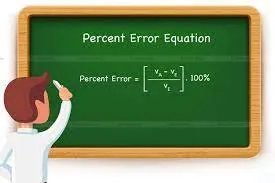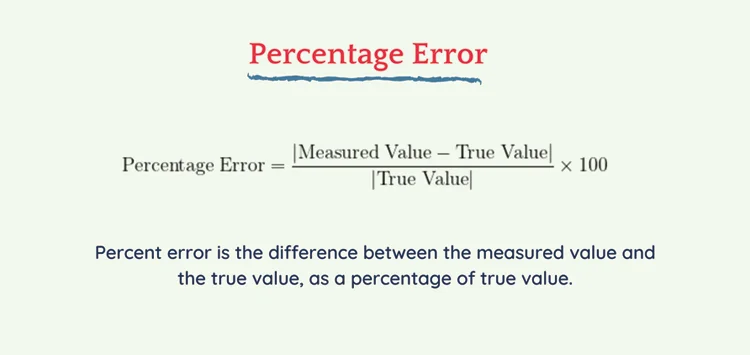Error Calculation Formula
In the realm of Mathematics Assignment Help, mastering error calculation formulas is crucial. These formulas play a pivotal role in assessing the accuracy of mathematical models and experimental results. One commonly employed formula is the Mean Absolute Error (MAE), which measures the average magnitude of errors between predicted and actual values. Another significant formula is the Root Mean Square Error (RMSE), providing a comprehensive evaluation by considering the square of errors. Precision in these calculations ensures the reliability of mathematical solutions and experimental outcomes, making them integral to academic success. Students seeking Mathematics Assignment Help benefit from a deep understanding of these formulas, enabling them to navigate complex problem-solving scenarios with accuracy and confidence.
What Is The Fundamental Error Calculation Formula?
The fundamental error calculation formula, specifically for determining percent error, is essential in assessing the accuracy of measurements. To calculate percent error, the formula is expressed as [(|Experimental Value - Theoretical Value|) / |Theoretical Value|] × 100%. This method helps quantify the deviation between the obtained and expected results, offering insights into the precision of scientific or experimental data. Understanding how to calculate percent error is crucial for scientists, researchers, and students alike, as it aids in evaluating the reliability of experimental outcomes. By identifying and addressing discrepancies, this formula facilitates the improvement of experimental techniques and ensures more accurate future measurements. Proficiency in using the percent error formula enhances scientific rigor and fosters a deeper understanding of the uncertainties inherent in various measurements.

How Do You Express Error Mathematically In A Formula?
In mathematical terms, expressing errors involves employing formulas that quantify the discrepancy between a measured or calculated value and its true or expected counterpart. Typically denoted as 'Δ' (delta), error is articulated as the absolute or relative difference, relying on the specific context. For instance, absolute error is computed as the absolute value of the difference between the measured and true values. The relative error, on the other hand, is expressed as the absolute error divided by the true value, multiplied by 100 to yield a percentage. These mathematical representations facilitate precise assessment and correction of inaccuracies in various scientific and computational disciplines. So, when grappling with the complexities of mathematical expressions, seeking assistance with the phrase "do my assignment" may be a prudent step towards mastering these calculations.
Can You Outline The Formula For Calculating Absolute Error?
For mathematics brilliant candidates seeking precision, understanding the formula for calculating absolute error is crucial. The absolute error is determined by subtracting the measured value from the true value, yielding the numerical difference without considering direction. The formula is expressed as Absolute Error = |True Value - Measured Value|. This method ensures an accurate representation of the deviation between experimental and actual results. Best options for mathematics brilliant candidates involve mastering this formula, as it is fundamental in various disciplines, including physics, engineering, and statistics. Proficiency in calculating absolute error enhances analytical skills, critical for aspiring mathematicians, scientists, and researchers striving for precision in their work.
What Is The Significance Of The Relative Error Formula?
The relative error formula holds immense significance for an online assignment writer, serving as a crucial tool to assess the accuracy of numerical computations. This formula compares the difference between a calculated value and its actual counterpart relative to the actual value. For online assignment writers, precision is paramount, making the relative error formula an essential component in evaluating the reliability of results. It enables writers to gauge the degree of accuracy in their calculations, fostering a meticulous approach to numerical tasks. Embracing this formula ensures assignments meet rigorous standards, enhancing the overall quality of work delivered. Online assignment writers, equipped with the relative error formula, can demonstrate a commitment to precision, elevating the academic and professional integrity of their assignments.
Can You Outline The Steps Involved In The Error Calculation Formula Covered By BookMyEssay?
BookMyEssay, a reliable academic writing service, may cover various error calculation formulas depending on the subject. However, a generic outline of steps involved in error calculation typically includes:
- Define the Objective: Clearly state the purpose of the calculation, whether it's measuring accuracy, precision, or another metric.
- Collect Data: Gather relevant data points or measurements for analysis.
- Calculate Deviations: Find the difference between each data point and its corresponding expected or true value.
- Square Deviations: Square each deviation to ensure all values are positive and to emphasize larger errors.
- Total Squared Deviations: Compute the total of all squared deviations.
- Calculate Mean Squared Error (MSE): Divide the sum of squared deviations by the number of data points.
- Root Mean Squared Error (RMSE): Take the square root of MSE for a more interpretable metric.
- Interpret Results: Analyze the calculated error to draw conclusions about the model's performance.
Always adapt these steps to the specific error calculation formula provided by BookMyEssay for a given task or subject.








 3 Bellbridge Dr, Hoppers Crossing, Melbourne VIC 3029
3 Bellbridge Dr, Hoppers Crossing, Melbourne VIC 3029



